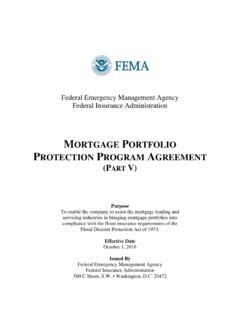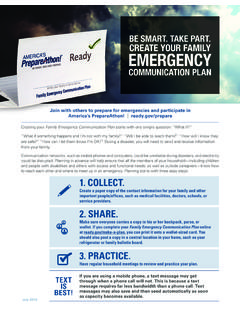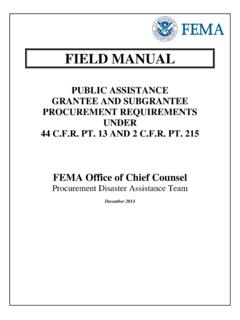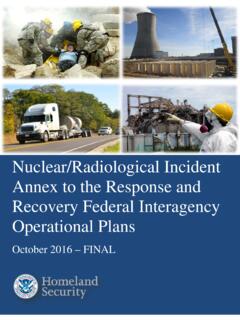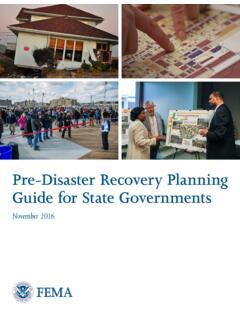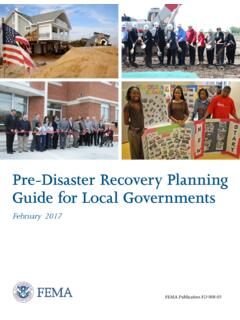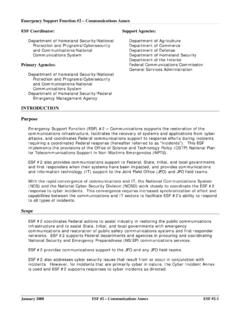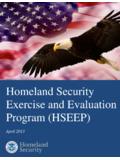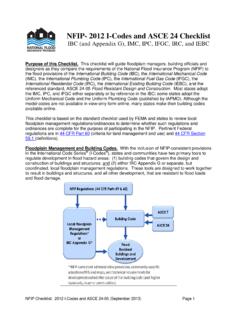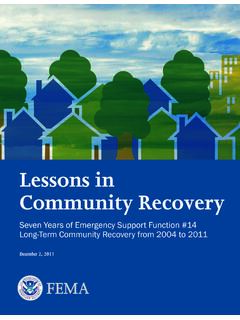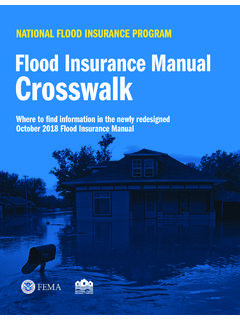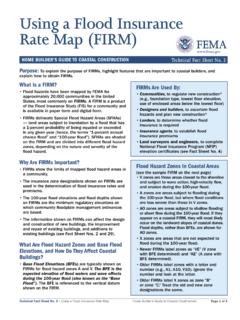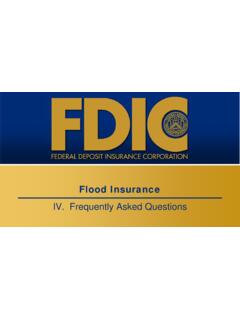Transcription of Map Changes and Flood Insurance - fema.gov
1 For more information about NFIP Flood Insurance call 800-427-4661 November 2018 NATIONAL Flood Insurance PROGRAMMAP Changes AND Flood property owners need to is a Flood map and why does it change?The Federal Emergency Management Agency ( fema ) works with community leaders across the country to identify Flood hazards and promote ways to reduce the impact of those and other hazards. Flood maps are used for floodplain management, Flood Insurance rating, and Flood Insurance requirements. Flood maps generally show a community s Flood zones, regulatory requirements for the elevation or Flood -proofing of structures, and floodplain boundaries; together they show the risk of flooding.
2 High-risk zones, known as Special Flood Hazard Areas or SFHAs, show where floodwaters will be in a Flood that has a one percent chance of happening in any given year. Moderate- to low-risk zones are where the risk of that level of flooding is less than one percent per year. No matter where you live or work, some risk of flooding hazards change over time. How water flows and drains can change by new land use and community development or by natural forces such as changing weather, terrain Changes , or wildfires. To better reflect the current Flood risk conditions, fema uses the latest technology to update and issue new Flood maps nationwide to aid communities, property owners, and other stakeholders in taking steps to address Flood are Flood maps used?
3 Community officials use Flood maps to help them understand and communicate the local Flood risk, manage their floodplains, and require new and substantially-improved buildings to be built more safely and mitigate losses from future floods . These efforts make a safer community in which to live and lenders use them to help determine a property s Flood risk and decide whether to require Flood Insurance as a requirement for a professionals use the maps to determine a property s Flood risk and Insurance and builders use them as part of their location siting and construction and business owners use Flood maps to learn about Flood risk as they purchase property and investigate how best, financially and tangibly, to protect their property from do Flood maps show Flood risk?
4 Flood maps show the different Flood zones. Moderate-to low-risk areas are labeled Zone X (or Zones B and C on older maps). High-risk areas begin with the letters A or V. Areas where the risk is not known are shown with the letter D. Base Flood Elevations (BFEs) displayed on Flood maps show the lowest height that floodwaters can be expected to reach during a major Flood and that participating NFIP communities must consider in making floodplain management is the risk shown on the Flood maps reflected in Insurance premiums?If your building is in a high-risk area, you are likely to pay a higher Flood Insurance premium than someone in a moderate- to low-risk area.
5 The exact amount you pay is based on several things, including the Flood zone and elevation of the a high-risk area, your Insurance premium may also depend on when your building was built compared to the date of the community s first Flood map. Some buildings built before the community s first Flood map, called pre- Flood map, are eligible for discounted can I reduce my rates?If you find you will have to pay a higher premium for Flood Insurance , you can take these steps to help reduce the cost: Mitigate. Lowering your property s exposure to flooding may make you eligible for lower premium rates.
6 For example, you can fill in a basement or install Flood vents in the crawlspace beneath the lowest level of your building; these actions help reduce the chance that your building s foundation will be damaged during a Flood and may lower your Insurance premium. When remodeling or rebuilding, you can consider elevating your entire structure. Also, something as simple as raising heating and cooling systems, water heaters, the electrical panel, and other mechanical items so that they are less likely to be damaged or destroyed in a Flood may offer some premium savings. Talk to your local floodplain administrator or review fema s Homeowner s Guide to Retrofitting at Encourage community action.
7 You can encourage your community to participate in the Community Rating Service (CRS), if it doesn t already. CRS is a voluntary incentive program that recognizes communities for implementing floodplain management practices that exceed the National Flood Insurance Program (NFIP) minimum requirements. In exchange for a community s proactive efforts to reduce Flood risk, policyholders can receive reduced Flood Insurance premiums. For more information, visit munity-rating-system. Apply for a Letter of Map Change (LOMC). Flood maps are developed at a mapping scale that is useful for community officials, lenders, and Insurance professionals, but not every rise in terrain can be depicted at this scale.
8 If you think your building is incorrectly depicted as being in a high-risk area, fema has a process that allows property owners to request an official Flood zone determination. This process includes the Letter of Map Amendment (LOMAs). A LOMA can be requested if a property is depicted as being in a high-risk Flood zone but is actually on naturally high ground. For more information, visit Consider a higher deductible. Just as with automobile or homeowners Insurance , increasing your deductible the amount you pay out of your pocket to cover a claim before coverage is applied will lower your premium.
9 Selecting the maximum deductible of $10,000 will result in up to a 40 percent discount from the base premium. However, using the maximum deductible might not be appropriate in every financial circumstance, and some lenders might not allow that option for meeting the mandatory purchase can I learn more?If a mapping project is occurring in your community, stay in contact with your local floodplain administrator to learn when and where Changes are occurring. When a preliminary Flood map is released, that map and the current Flood map will be available online at hear about ways to reduce your Insurance premium such as grandfathering, choosing a higher deductible, mitigating the risk, or the newly mapped rating option ask your Insurance agent or community officials to determine what may be most effective in your situation.
10 To learn more about Flood Insurance , talk to your Insurance agent or visit speak with a Flood map specialist, contact the fema Map Information eXchange (FMIX) at 877- fema -MAP (877-336-2627).What if I am newly mapped into a different Flood risk zone?This chart shows how map Changes can impact Insurance rates. For rating information specific to your property, contact your insurer or IN RISKRATE IMPACTFrom: Moderate- to low-risk area (Zone B, C, or X) or Unknown (Zone D)To:High-risk area (Zone A or V) Flood Insurance is mandatory in an SFHA. Flood Insurance is required if you have a mortgage from a federally regulated or insured options can offer savings.
